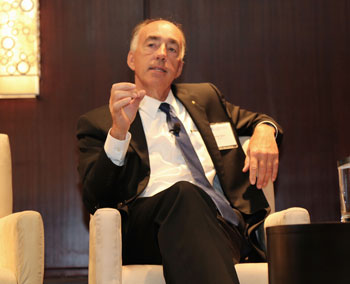From Drug Pricing To Innovation: Bayer’s Blake Shares 30 Years Of Insights
This article was originally published in The Pink Sheet Daily
Executive Summary
Philip Blake, the head of Bayer’s Americas operations, talked about some of the industry’s most pressing trends and issues at the Pharmaceutical Strategy Conference.
Bayer HealthCare Pharmaceuticals Americas region head Philip Blake shared his experience from decades working in the pharmaceutical industry at Informa’s Pharmaceutical Strategy Conference in New York Sept. 29. He voiced his opinions on a wide range of issues impacting the industry from drug pricing to R&D and fostering innovation within big pharma.
Bayer HealthCare Pharmaceuticals is a subsidiary of Bayer AG, for which Blake has worked in a wide range of roles for 30 years. He even joked about how he once was compensated by the German pharma with £6,250 a year, a “small little” bonus and a Ford Cortina.
Now, he oversees the diversified health care company’s Americas business, including the US, Canada and Latin America. The expanded role was announced Oct. 1; he previously led the US business as president since 2012, a position that will be filled by Habib Dable, who most recently led Bayer Healthcare Pharmaceuticals’ specialty medicines business.
Bayer is in the midst of a transition as it emphasizes life sciences, including businesses in pharma, animal health, crop protection and consumer health. The company announced plans to spin off its material sciences business last year and acquired Merck & Co. Inc.’s consumer health care business (Also see "Bayer’s Early R&D And Animal Health To Get Boost After Material Sciences Sell-Off" - Pink Sheet, 18 Sep, 2014.).
Bayer Americas Head Philip Blake at PSA
Brenda Sandburg for "The Pink Sheet"
Blake on the value of diversification:
In pharmaceuticals, as we all know, you have these big cycles of boom and bust. Many other companies deal with this by having to do consolidation because they slide over the patent cliff, unable to keep this long cycle machine going of innovation… We all know, all parts of the industry, the traumas caused by the downsizing, the upsizing, the huge amount of acquisitions, all of the costs we go through by bringing companies in and spinning them out.
That is a huge drag when it comes to R&D because R&D has that long cycle. We see the benefits of being in consumer health, which is somehow countercyclical to pharmaceuticals, but also being in the crop business. And those of you who have not watched the crop business recently, it is fascinating. You are achieving almost pharma-like margins by using technologies that are pretty impressive.
On pharma innovation:
It is very rare to see these huge transformational steps forward. That’s just not the way our industry works. I think we have to admit it. We work by incremental innovation. Sometimes those increments lead to bigger steps, sometimes we are working, working and working and then we get a jump. We were highly criticized in the industry in the '90s for showing very little innovation. The people who wanted to make politics out of our industry claimed that what we were actually doing was simply ‘me too.’ It wasn’t. It was very gentle incremental innovation, learning, building knowledge.
How do you know it is innovation? It is one of these difficult things. You can’t define it but you know it when you see it. Which brings us then to the question how do you get that nose for innovation, how do you build that ability to recognize innovation? Many of us here are from the commercial side of the business. Some of us have a career where we have moved from the development side to the commercial side, back to development again. I think that helps us get a nose for innovation because you can determine what the science is but your commercial side then gives you a way of figuring out is there an opportunity here, is there an unmet need for this innovation. That is the sort of game that has to go on.
On internal versus external R&D:
We believe in the innovation piece. We are increasing the amount we spend on R&D. It was somewhere like €3.1bn in 2010, €3.6bn, something like that, in 2014. We are accelerating the amount we spend on R&D. We are reducing the amount we spend as a percent of sales on commercial and increasing in R&D, about a 2% switch, because we believe that is the source of value in this industry… We do look at partnerships as being a way particularly of front-ending some of the innovation. Our footprint in the US is not that large in bricks-and mortar-research, so we tend to partner more aggressively in the United States than we would perhaps in Europe… which works well for us because the US is clearly at the center of innovation.
On innovation hubs:
You need to be working where great minds are. That means you have to partner. We are up in Boston working with the Broad Institute. … We are trying to figure out the genomics of cardiovascular disease to educate us on how to strengthen research in those areas. The Broad Institute is a fascinating place to be. There is no way we can model the economic payoff of being there. It is so far out there. We believe that by being in this hub where some of the greatest minds are is part of that, being part of the environment, the exchange of scientific ideas. But also putting some of our commercial folks there helps us then identify innovation because when you see it you know it.
We are also doing some fun stuff out in San Francisco… We have a classic bricks-and-mortar research set-up there at the University of San Francisco, just around the corner, where we make lab space available for businesses, spin-out companies that are coming out of Stanford and [other] universities. These are soft landings for small little start-up businesses. They literally rent bench space by the foot. We create a community of our own scientists and the other people who are there, so they share the space in the coffee rooms. There are people there who if they are stuck can help them run equipment. There is the exchange of ideas. We give them opportunities to present their work. In three or four occasions now, these small start-up companies, we preferentially give them opportunities then to become part of our research network, to try to encourage them and grow them. This collaboration is pretty exciting. It’s good to see…Is something going to come out of it? Who knows? Without trying out, you aren’t going to get there.
On failure:
A mistake is where we make the wrong decision. We didn’t collect the right information. We all make mistakes. We can make sure we get a better process for next time. Failure is when, looking back, you think something didn’t work out, but looking back actually at the time you made the right decision, but the molecule just didn’t work out in development. We have to help people become failure-tolerant. We have to reduce the number of mistakes we make. We generate a good process. It is in our industry. We have to be able to embrace failure because we are going to get failures. They are always going to happen. It is the nature of development.
One of the best places to become failure-tolerant is giving people a first-line commercial role. Within a first-line commercial role, you are getting decisions thrown at you all the time: to accept this contract, do we take this price, do we hire this person, do we readjust our organization this way to adapt, do we change the amount of resources we put on this product versus that product? You are going to get more than your fair share of failures. You are going to have to learn to become humble, less arrogant.
On drug pricing:
We in the industry owe it to ourselves to recognize the good things that are happening. A few years ago, there was a justifiable criticism that our innovation was incremental and marginally incremental. We were struggling as an industry. We were at the end of that era of this high-throughput screening model that we thought would industrialize innovation. It really wasn’t working. We have seen this significant burst of innovation. I don’t think anyone can doubt: checkpoint inhibitors, PCSK9s, this whole potentiator/corrector stuff [in cystic fibrosis] that Vertex is doing. There is a lot of scientific stuff that is making significant impact on disease progress at the moment. We should not shy away from being proud about that innovation.
In this country, there is clearly an ability to pay. … There is definitely a willingness to pay and ability to pay. We owe it to ourselves to be proud of the innovation and to handle that appropriately. Where we see ourselves getting into trouble is not innovating and handling pricing in the wrong way. That is what we have to manage. And that is our own responsibility.

